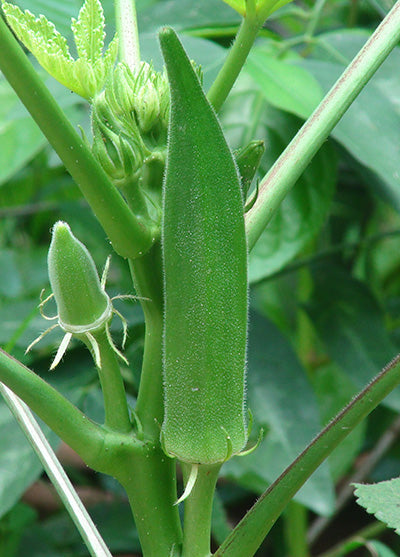Okra Is A Popular Vegetable In The American Southeast
Okra, sometimes called Lady Finger or Bindi, is a kitchen garden essential for cuisine such as Cajun, Indian, African, and it's served all over the Southeastern part of the United States.
Tricia shows you how to grow okra in the video How to Plant Organic Okra. This gorgeous plant will grow to about five feet tall and will provide beautiful hibiscus like flowers (it is related to Hibiscus and cotton) and seed pods that are yummy all summer long.
Varieties of Okra
Spineless green okra is a gardeners favorite as it is easier to harvest and it produces abundantly. Red or burgundy okra is a pretty choice for pickling and raw eating however the pods will turn green if cooked. Okra loves the heat. It can grow in any zone where corn and melons can be grown.
Planting and Growing Okra
You can plant okra seeds directly in the garden as long as the soil temperature has reached 75°F. Okra sprouts better if you pre soak the seeds for 12 hours before planting. If you want a head start, start your seeds 3 weeks before the last frost date in a greenhouse. Use biodegradable pots or soil blocks so you don't disturb their sensitive roots when transplanting. Okra plants tolerate just about any kind of garden soil so as long as they get full sun. Transplant or thin your plants to 1 to 2 foot spacing with 3 feet between rows. Since it gets so big consider how it will shade nearby plants when planning where to grow it. Mulch your okra plants when they're about 4 inches tall to prevent weeds and to conserve soil moisture. Okra has fairly shallow roots and it is best to either weed by hand or use very shallow cultivation.  Plants will start to produce flowers about 2 months after planting. Pick to pods when they are about 3-4 inches long. Use shears to cut pods from plant. If the okra pods get too large they will be tough and inedible.
Plants will start to produce flowers about 2 months after planting. Pick to pods when they are about 3-4 inches long. Use shears to cut pods from plant. If the okra pods get too large they will be tough and inedible.
To keep your okra plants producing, they should be picked every 1-2 days. Some people are sensitive to contact with the okra plants and may develop some itching. To avoid this wear a long-sleeved shirt and gloves while harvesting the plants.
Refrigerate dry, unwashed okra pods in the vegetable crisper loosely wrapped in breathable plastic bags (like the ones used in supermarkets). Okra can be stored in the refrigerator for 2-3 days for fresh use. Once pods begin to darken, they should either be used or discarded. Check out our recipes on our Gardening Resource Center for a couple of ways to use okra. Saving seed is very easy for okra. Towards the end of the season (when it starts to cool off), you should leave a few of the pods until they get large. Allow them to dry on the plant, shell the seeds and store in a cool dry location for planting the following season.
Pests and Diseases Common to Okra
Okra pests include aphids, stink bugs, beetles (flea, Japanese and cucumber) and corn earworms and root knot nematodes. Sticky traps can be placed out by the plants to catch some pests or use a product that is labelled to control the pest. Diseases common to okra includes Verticillium wilt, Pythium, Phytophthora. There are some products available to control the diseases that you may find on your okra plants. Read and follow the label for diseases controlled and application instructions. Grow some okra in your garden this summer and enjoy some great southern fried okra or a some Cajun gumbo!
We carry may types of okra seeds for sale!

